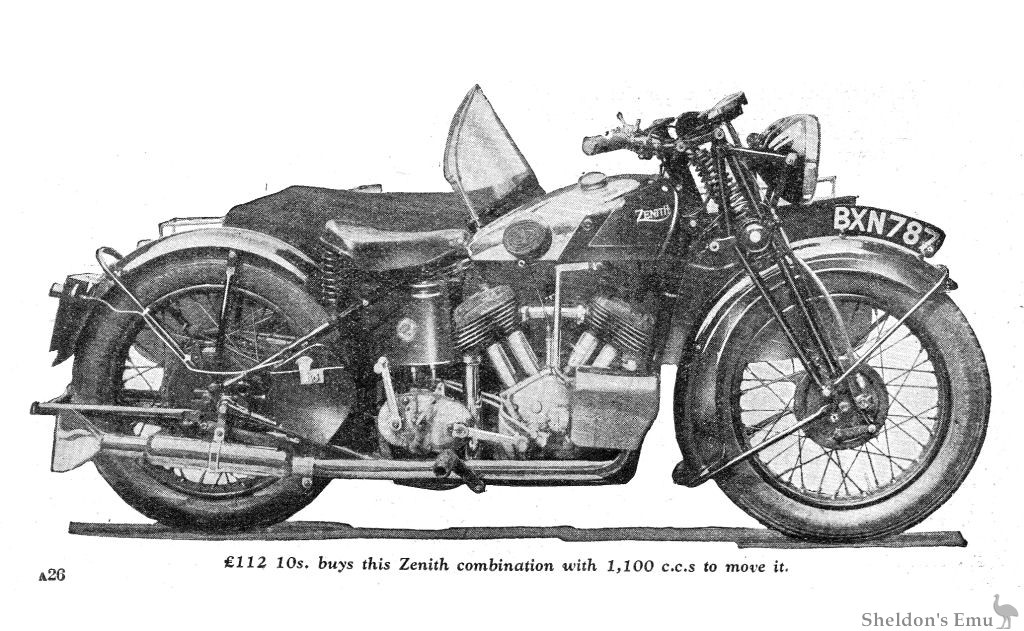Brief Specification of the Zenith C.P. Combination
Engine: Bore 85.7 mm., stroke 95. mm. = 1,096 c.c,; 60-degree S.V, twin; special J.A.P.; detachable heads; enclosed valves; roller bearing big-end; ball-journal bearings to mainshafts; aluminium pistons; compression ratio 5 to 1; bevel-drive Lucas Magdyno; Amal carburetter; dry-sump lubrication.
Gearbox: Burman pivotal four-speed; positive stop foot control, 15s. extra.- Ratios, 4.34 to 1, 5.47 to 1, 7.33 to 1 and 11.59 to 1.
Transmission: 5/8-in. by 3/8-in. chains; primary drive in oil-bath case; rear drive protected by guard over top rim; positive lubrication to rear chain; shock absorbers incorporated in clutch and engine shaft.
Frame: Cradle type, with built-in sidecar lugs; extra heavy special Druid forks with built-in hand-operated shock and steering dampers; adjustable footrests; heavy-gauge D-section mudguards, with detachable portion at rear; front wing deeply valanced; spring-up rear stand; clip-up front stand.
Handlebars: Fully adjustable; semi-touring; black; throttle twist-grip; attached levers.
Brake: 8-in. rear, heavily ribbed; 7-in. front; interconnected; finger adjustment.
Wheels: Roller bearing hubs; 27-in. by 4.00-in. Dunlop tyres.
Tanks: Petrol: Chromium-plated, with purple and black panels; 3 gallons capacity. Oil: 1/2-gallon capacity, mounted on seat tube.
Equipment: Lucas Magdyno; Altette horn; Dunlop waterproof saddle, licence holder; Smith trip large-dial speedometer.
Sidecar: Watsonian launch model; purple panels; all-steel construction; oak-finished decks, with chromium-plated rails and ventilator ; celluloid sports screen; door; hood and cover-all apron; "O" springs at rear, four coil springs at front; quickly detachable body bearer bars; streamlined electric lamp on helmet-type wing; knock-on hub cap; chassis attached at four points.
Dimensions: Overall length, 7 ft.; width (solo), 29 ins., (combination) 59 ins.; wheelbase', 58 ins.; saddle height, 26 1/2 ins.; ground clearance, 5 ins.
Price: As tested, £112 10s.
Annual Tax: £3 (16s. quarterly).
Insurance under " Motor Cycling " Policy: London postal area and Glasgow, fully comprehensive £6.12s., third-party only £2 11s.; London Metropolitan Police area (excluding the postal area) and Lancashire south of the River Ribble, fully comprehensive £5 14s., third-party only £2 3s. 6d.; elsewhere, fully comprehensive £5 14s.; third-party only £1 16s.
Extras: Carrier or pillion seat, 12s. 6d.; Lucas stop light, 7s. 6d.; clock, £1 10s.: pillion footrests 7s. 6d.; chromium-plated wheel rims, 10s.
Makers: Zenith Motors, Hampton Court, Surrey.
£112 10s. buys this Zenith combination with 1,100 c.c.s to move it.
A feature of the Zenith which will compel the attention of long-distance tourists is the 3-gallon petrol tank. The contents of a tank-full were found sufficient to last the Zenith 126 miles at a maintained speed of 45-50 m.p.h., thus demonstrating the "thirst" of the machine to be 42 m.p.g.
Another noteworthy detail of the Zenith is the method of enclosing the valve springs and tappets. These. are encased in split tubes secured by quick-action fastenings. A single downward movement of the detachable part of each tube 'suffices to release it from its anchorage and discloses the tappet adjustment. The position of the Magdyno, too, lends itself to ready inspection, and the neat aluminium shield over the instrument is easily taken off. when required, the cables being led through a metal conduit secured by accessible bolts.
The "electrics" of the Zenith were up to the usual Lucas standard. The h.f. horn, mounted forward on the fourth sidecar connection, gave forth a courteous yet attention-compelling note, and the lights were such that night riding on the machine was quite a pleasure. At a speed of 40 m.p.h, on charge, the ammeter registered a flow of 2 amps, to the battery, this being increased to 4 amps, when
the sidecar, tail and pilot bulbs were in use. With the headlamp in action, the consumption of the lamps was equalled by the output of the dynamo, there being a slight discharge when the road speed of the machine-fell below 40 m.p.h. The comparatively slow engine speed below this gait seemed to call for a higher dynamo output at low revs.
So far as the sidecar is concerned, this is a soundly built and comfortable carriage, the weather shielding and upholstery being well carried out. A large door gives access to the body; the screen, with its hood-cloth apron, is held rigidly in position by spring clips mounted on the gunwales. The neat sports hood gives ample protection, while allowing plenty of headroom for the passenger, and when no super-cargo is carried, a " tonneau-cover " is stretched over the interior of the body from the lower edge of the screen to the forward end of the rear decking.




